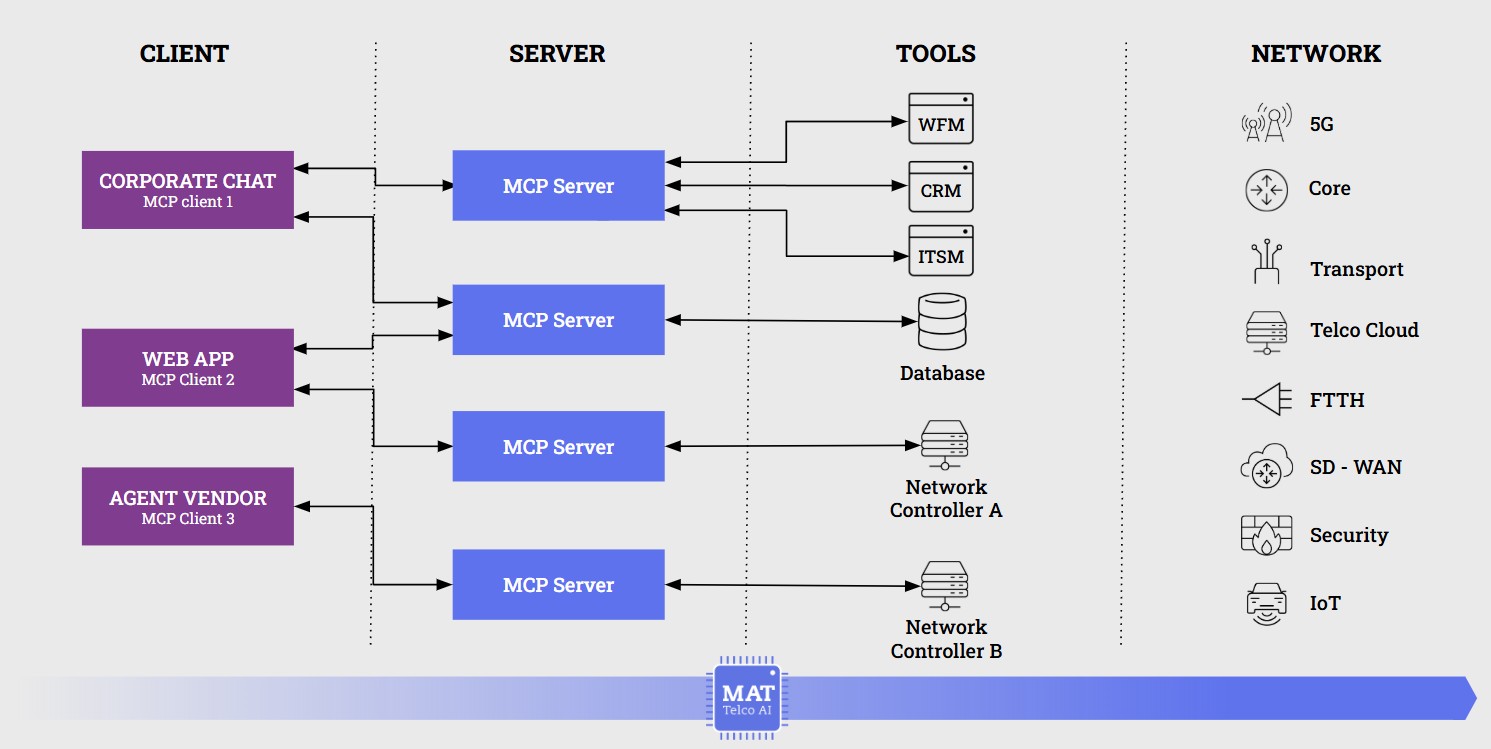
MCP: An Open Standard for AI Integration in Telco
MCP (Model Context Protocol) is an open standard developed by Anthropic to unify how AI models interact with external data sources, systems and tools. Dubbed the “USB-C of AI applications,” MCP provides a universal connector between language-based agents and the software they need to call. Since its public release in November 2024, it has seen rapid adoption by leading platforms, including Google, Microsoft (Azure and Windows) and most recently OpenAI. In practice, MCP replaces a myriad of bespoke connectors with a single, consistent interface, making it far simpler to link AI models to wherever enterprise data lives.
It may seem that MCP is solving “future” problems, and indeed it addresses challenges that many organizations haven’t yet encountered. But in a field where each semester brings massive technological leaps, service providers risk missing out on new efficiencies and revenue streams if they delay experimentation or get bogged down in custom integration work. While it’s too soon to declare MCP the definitive standard, its momentum among key players makes it a critical technology for telco architects and engineers to investigate now.
MCP Framework: Components and Architecture
MCP is based on a client-server design with well-defined roles. At a high level:
- Host: The orchestrating application that loads and manages one or more MCP clients. This could be a desktop IDE (for example, VS Code or Zed) or a dedicated assistant app (for example, Claude Desktop). The host is responsible for spinning up clients, routing messages and managing each MCP connection.
- MCP Clients: Lightweight interfaces running inside the host. Each client maintains a bidirectional channel to a specific MCP server, handling JSON-RPC 2.0 messaging, requests, responses and notifications, over either standard I/O (for local servers) or HTTP (for remote endpoints). Think of MCP clients as “virtual cables” that link the model to each external system.
- MCP Servers: Stand-alone components that expose external systems—databases, document repositories, third-party APIs, ITSM platforms or orchestration engines—as MCP-compliant endpoints. Each server translates between the MCP protocol and its backend’s native interface, turning model requests into real actions (queries, commands, lookups) and packaging results back into a structured JSON response.

This modular architecture lets you add, replace or remove connectors without touching the host or other clients. Whether a server runs on-premises or in the cloud, whether it talks to an SQL database, a RESTful API or a network-management bus, it all looks the same to the model: an MCP server it can call.
Core Primitives
Rather than defining endless custom operations, MCP standardizes on three fundamental primitives that any compliant server can provide:
- Resources: Structured data objects—document fragments, query results, log entries or binary assets—that the server makes available via standardized references (IDs, URIs).
- Prompts: Prebuilt instruction templates tailored to specific tasks or domains.
- Tools: Executable functions or actions—running a query, invoking a microservice, creating a ticket, triggering an orchestration workflow.
By building every connector around these three building blocks, MCP makes integrations predictable and reusable.
Foundational Principles
MCP is designed around four guiding principles:
- Standardization: One protocol for every data source and tool cuts the integration burden dramatically.
- Interoperability: A server built for one platform can serve any other that speaks MCP, because the protocol is provider-agnostic.
- Scalability: New data sources or AI models plug in without rewriting existing code.
- Security: While MCP defines how messages flow, implementations must enforce authentication, authorization and audit controls as needed.
Telco-Focused Use Cases
For operators managing complex, heterogeneous networks and support systems, MCP offers a fast track to AI-driven automation:
First Line Support Agent
A virtual assistant built on MCP can act as an omnichannel first line of support, querying diagnostic platforms, knowledge bases, incident-management tools and configuration databases in milliseconds. By removing legacy frustration points—such as IVR menus or traditional rule-based chatbots—it delivers a seamless experience across voice, web chat and mobile apps, combining all that data into a concise, accurate answer.
Change Management Assistant
An AI agent handling maintenance windows and change requests leverages MCP to interact with ITSM, network inventory and orchestration layers, and can even coordinate with other specialized agents that execute the maintenance operating procedure (MOP). It runs pre-checks and post-checks in a single automated workflow, ensuring each change follows governance policies and minimizing manual handoffs.
In both scenarios, a human-in-the-loop remains available for oversight and exception handling, but the frequency of required interventions is reduced dramatically.
Next Steps: Two Possible Scenarios
- Early Adoption & Rapid Value
If MCP becomes the de facto protocol, your pilots will translate directly into production-ready integrations and unlock faster time-to-market for AI-driven services. - Insight-Driven Readiness
If MCP evolves into a different standard or spawns competing protocols, the lessons you gather on connector design, security models and workflow orchestration will streamline your path when the industry settles on its definitive integration standard.
Start experimenting with MCP now, build connectors, run tests and share your findings. Whether you ride MCP’s initial momentum or leverage your experience toward the next protocol, your work today will shape the future of AI in telco.


